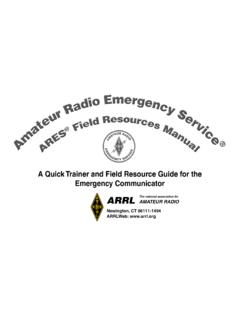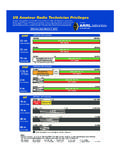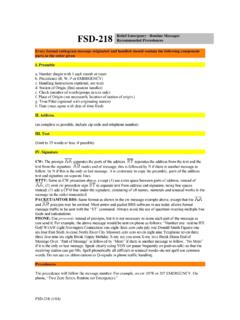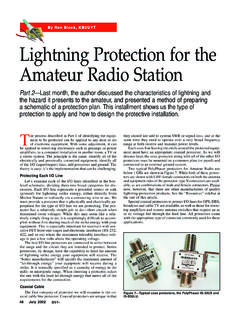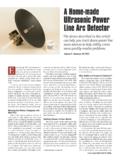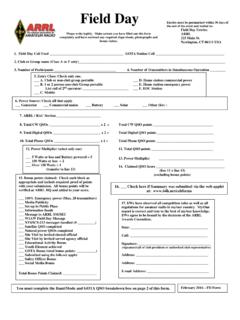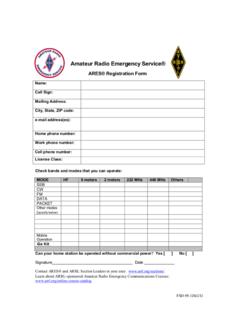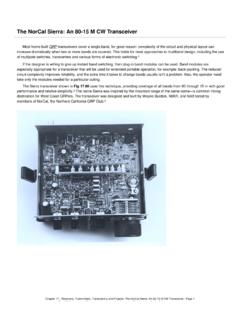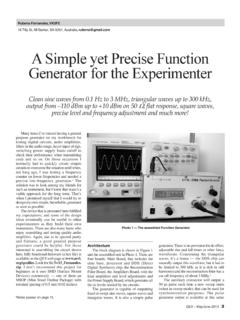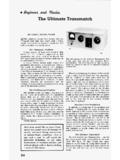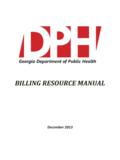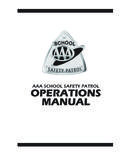Transcription of Chapter One: The National Traffic System
1 Chapter One: The National Traffic System The National Traffic System (NTS) is a structure that allows for rapid movement of Traffic from origin to destination and training amateur operators to handle written Traffic and participate in directed nets. These two objectives, which sometimes conflict with each other, are the underlying foundations of the NTS. NTS operates daily, even continuously with advanced digital links. The personnel consists of operators who participate for one or two periods a week, and some who are active daily. The National Traffic System is an organized effort to handle Traffic in accordance with a plan which is easily understood, and employs modern methods of network Traffic handling in general acceptance today.
2 NTS is not intended as a deterrent or competition for the many independently-organized Traffic networks. When necessitated by overload or lack of outlet for Traffic , the facilities of such networks can function as alternate Traffic routings where this is indicated in the best interest of efficient message relay and/or delivery. One of the most important features of NTS is the System concept. No NTS net is an independent entity which can conduct its activities without concern for or consideration of other NTS nets. Each net performs its function and only its function in the overall organization. If nets fail to perform their functions or perform functions intended for other nets, the overall System may be adversely affected.
3 Nets may sometimes find it necessary to adopt temporary measures to ensure the movement of Traffic , and this is considered improper operation only when no attempt is made to return to the normal schedule. Nevertheless, improper operation of any NTS net is the concern of all NTS nets, and every effort should be made to assist in returning any non-functioning or improperly functioning net to its normal operation. Membership in NTS Individual station participation in NTS is recognized by issuance of certificates, and by appointment to the field organization's Traffic handling position, the Official Relay Station. Organizationally speaking, the "members" of NTS are the nets and digital nodes which participate therein.
4 Most nets and many of the NTS-sanctioned nodes were created and organized for NTS purposes only and operate for specific purposes to be described later. Procedures are somewhat specialized, particularly at Region, Area and TCC levels. Frequently, ARRL Headquarters is asked how a net or digital node (BBS) may become a part of NTS. This usually isn't easy, because NTS is not a "club for nets" which any existing net may join at will. In addition, making nets a part of NTS is less a matter of official action than a "state of mind" of the net itself. In this connection, the following points deserve mention: Nets or packet nodes (BBS's) operating within ARRL section boundaries, or otherwise at local or section level, may become a part of NTS by performing the functions of such.
5 Nets whose coverage extends beyond section boundaries but within region (roughly, call area) boundaries may become a part of NTS only by foregoing their general membership and setting up to operate as a session of the region net. Such nets would act as one of that region's net sessions and would be under the jurisdiction of the region net manager appointed by ARRL. All present NTS region nets were organized specifically at the outset for NTS region coverage. HF digital stations capable of storing-and-forwarding NTS messages in a System of such stations may be certified as NTS Digital Relay Stations by NTS Officials known as Area Digital Coordinators. They are responsible for handling NTS Traffic to the same high standards as their counterparts in the traditional System .
6 Since operation at the area level is so specialized, it is not possible for nets whose coverage extends beyond region boundaries to be a part of NTS at any level. Any net or digital node which becomes a part of NTS is expected to observe the general principles of NTS procedures. Generally speaking, participation in NTS is best performed by individual-station participation in an already-existing NTS net, at any level. Lack of recognition as an NTS net does not imply that such a net is without ARRL recognition or support. Many public service nets on which information is received are included in the League's on-line Net Directory, and activities are often summarized in the appropriate part of the ARRL Web.
7 Although NTS is the League-sponsored organization for systematic Traffic handling, it is far from being the League's only interest in public service communication. Mode The National Traffic System is not dedicated specifically to any mode or to any type of emission, nor to the exclusion of any of them, but to the use of the best mode for whatever purpose is involved. The aim is to handle formal written Traffic systematically, by whatever mode best suits the purpose at hand. Whether voice, CW, RTTY, AMTOR, packet or other digital mode is used for any specific purpose is up to the Net Manager or managers concerned and the dictates of logic. There is only one National Traffic System , not separate systems for each mode.
8 Modes used should be in accordance with their respective merits, personnel availabilities and liaison practicalities. Whatever mode or modes are used, we all work together in a single and thoroughly integrated National Traffic System . Chapter Two: Principles of NTS Operation The National Traffic System includes four different net levels which operate in an orderly time sequence to effect a definite flow pattern for Traffic from origin to destination. A message flows through the National Traffic System in a manner similar to an airline passenger who starts out in a small residential town with a destination across the continent in another small town. He has to change carriers many times in the process, starting with a local ground conveyance to a feeder airline, to a transcontinental airline, to another feeder airline, then local transportation to deliver him to his destination.
9 In a very similar manner, the transcontinental message starts with the originating station in a local net, is carried to the section net, the region net, the area net, via Transcontinental Corps (TCC) to a distant area net and then back down the line to delivery. Of course the message, like the passenger, can "get on" or "get off" at any point if that's the origin or destination. Thus, a message from, say, New York to Detroit would never get on TCC, but would "get off" at area level. A message from San Francisco to Los Angeles would not go beyond region level, and one from Syracuse to Buffalo would remain inside the section net. Messages may also be passed through NTS-affiliated local and section Traffic nodes that employ digital modes with store-and-forward capabilities and bulletin board operations.
10 Long hauls can be made by NTS Digital Relay Stations at HF, that interface with Section Traffic nodes, and the traditional nets of the System . Figure 3, organization chart for the evening cycle four NTS setup in the Central Area. Local Nets Local nets are those which cover small areas such as a community, city, county or metropolitan area, not a complete ARRL section. They usually operate by VHF (typically 2-meter FM) at times and on days most convenient to their members; some are designated as "emergency" (ARES) nets that do not specialize in Traffic handling. The time slot designated for them is thus nominal and will vary considerably. Local nets are intended mainly for local delivery of Traffic , inasmuch as such delivery could ordinarily be effected conveniently by non-toll telephone.
